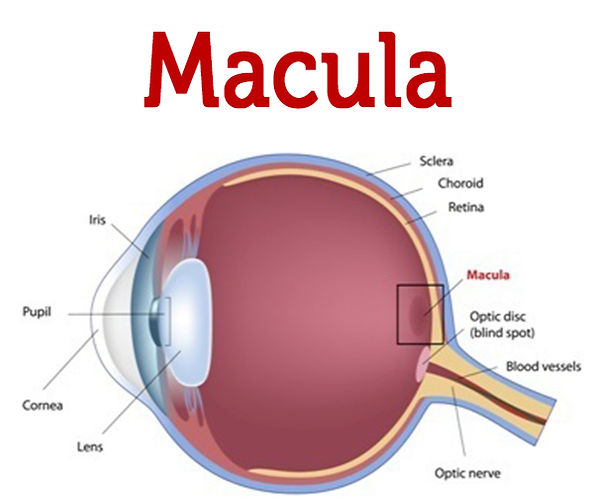
WELCOME
Welcome to your trusted guide on Age-Related Macular Degeneration (AMD). This website is designed to help you, your family, and your friends to understand AMD, its management, and the support available, using clear, evidence-based information tailored for all levels of health literacy.
Overview
What is AMD? (Age-Related Macular Degeneration)
Age-related macular degeneration (AMD) is an eye condition that gradually damages the macula, the small but important central part of the retina (32).
In Australia, one in 7 Australians aged over 50 shows signs of AMD, equating to approximately 1.5 million people. About 17% of those go on to experience vision impairment, and nearly 15% of Australians aged over 80 live with vision loss or blindness due to AMD (16).

(37)
Macula - The "Focal point" in camera

The retina captures light and sends signals to the brain.
The macula is the central “focal point,” allowing you to see detail and colour clearly. Damaging to this area can make everyday activities, like checking your phone or reading a menu, increasingly difficult (9).
(1)
Watch out! Are you At Risk?
Are you over 50 years old?
Do you have a sibling or family member that has AMD?
Do you smoke?
Have you had an experience of cataract surgery?
Do you have a cardiovascular disease?
Risk Factors
-
Age: The likelihood of developing AMD increases significantly after the age of 50 (25)
-
Family history and genetics: If a family member or sibling has AMD, your risk is higher. Knowing your family history can help your optometrist recommend earlier screening. (31)
-
Lifestyle choices: Smoking is one of the strongest modifiable risks for AMD. Limited physical activity, a diet low in leafy greens and antioxidants, and excessive alcohol consumption can also contribute to the progression (31).
-
General Health conditions: High blood pressure, experience of cataract surgery, high cholesterol, and cardiovascular disease can reduce healthy blood flow to the eye, which may accelerate retinal changes. (31)
-
Eye health and protection: Long-term exposure to UV light without eye protection may slightly increase risk (3). Wearing quality sunglasses and a hat when outdoors can help reduce this exposure. (21– infographics of risk factors)

(38)
(21)

Types of AMD
AMD can progress in diverse ways, and understanding the two main types helps you recognise symptoms and prompt care:
Dry (common, gradual changes)
Dry AMD develops slowly as many yellow deposits, known as drusen (8), build up under the retina. Over time, the macula thins, leading to gradual central vision changes. Many people with early dry AMD may not notice symptoms right away, but regular eye checks can help detect it early when lifestyle changes and monitoring can slow progression (29).

Wet (less common, urgent changes)
Wet AMD occurs when abnormal blood vessels grow under the retina. These fragile vessels can leak fluid or blood, causing sudden or severe central vision loss (24). Wet AMD requires urgent treatment, as early intervention with medications like anti-VEGF injections can preserve vision and improve long-term outcomes (30).
(39)

Symptoms, Diagnosis & Prognosis
(40)
(40)

Symptoms
AMD often begin subtly. Early signs may include blurred or distorted central vision, difficulty reading small print, and dark or empty patches in the centre of your visions. Colours may appear less vibrant, and straight lines may look wavy (5, 26).


Prognosis
Diagnosis
-
Optical Coherence Tomography (OCT): Produces detailed images of the retina (27).
-
Fundus photography: captures pictures of the macula to monitor changes over time (35).
-
Ambler grid test: helps detect distortion or missing areas in your vision (34).
AMD is progressive, but early detection and management can help slow its impact and preserve useful vision for longer. Regular eye exams and prompt treatment, especially for wet AMD, offer the best chance of keeping independence and equality of life (23).
(41)
(42)
(43)
Management and Treatment
Simple lifestyle Adjustments can slow the progression of AMD and support overall eye health. Stopping smoking is the single most effective step you can take, as smoking greatly increases the risk of vision loss (2). A balanced diet rich in leafy greens, colourful vegetables, and nutrients such as luetin and zeaxanthin supports macular health (7). Regular physical activity and maintaining a healthy weight improve blood flow to the eyes and can help protect retinal health (28).
Medical Treatments
-
Anti-VEGF injections: For wet AMD, medications such as randizumab or aflibercpet are injected into the eye to reduce fluid and bleeding, preserving vision and slowing further damage (22).
-
Photodynamic therapy (PDT): Less common today but may still be used in selected cases of AMD (4).
-
Low vision aids: Tools such as magnifiers, enhanced lighting and accessibility apps a can help you stay independent in daily life (6).

(44)
Monitoring
Regular eye exams are crucial, even if your vision seems stable. At home, an Amsler grid can help detect early changes, so you can seek care quickly if your vision shifts (33).
Still looking for a better treatment option?
Research into gene therapy and stem cell therapy is underway, offering hope for more effective treatments in the future (15).
Resources & Support
Living with AMD can feel overwhelming, but support is available to help you stay informed and independent.


(14)
(13)
-
Macular Disease Foundation Australia (MDFA): Resources, educational event, and a helpline for support (14).
-
Vision Australia: Low vision services, technology advice, and community programs (13).
-
Local low vision clinics: Provide training and aids to help maintain daily activities.
FAQs
- Can I Drive with AMD?
It depends on your level of vision and licensing rules. Regular check-ups will guide safe driving decisions (12).
- Will I go blind?
Most people with AMD keep some vision. Early treatment can preserve sight for years.
- How often should I have my eyes checked?
If you have AMD eye exams every 6-12 months is recommended, or sooner if you notice vision changes.

Cultural Considerations
This website acknowledges the specific needs of Aboriginal and Torres Strait Islander peoples. Culturally safe services, such as the Victorian Aboriginal Health Services and Closing the Gap programs, can help provide accessible eye care and support (11, 20)

Acknowledgement of country
We acknowledge the Wadawurrung people, the Traditional Custodians of the land on which we learn, live, and work here in Waurn Ponds. We recognise their enduring connection to the land, waters, and community. We pay our respects to Elders past and present, and we extend that respect to all Aboriginal and Torres Islander people today (19, 18).
(17)
